- Joined
- Jul 19, 2019
- Messages
- 118
I finally got around to finishing a fixture plate for my 8" rotary table. This turned out to be a little more involved than I was anticipating, but it was well worth it and I learned a lot.
I started with a piece of 8.250" diameter x 1.250" ductile cast iron and chucked it up in my lathe.
I faced the first side and turned it to a diameter of 8" x .800" thick. Then I flipped it in the chuck jaws. This gave me a nice, square face to sit up against the jaws of the chuck to be able to machine the other side.
With the material now turned down to finished diameter and length, I bored a 1.0713" hole through the middle. This hole will mate up to the 1.0708" OD feature on a setup tool that I built to serve two purposes.....#1-to center my rotary table to the quill of my mill vía the MT3 taper, and #2-to center the fixture plate on the rotary table. I ended up with a bore .0005" over that of the setup tool.
I then set up the plate on the mill and indicated off of the bore to find center. With my X and Y axis zeroed, I drilled the mounting holes that would attach it to the rotary table. One of the feautures I wanted to have, was a relatively easy way to align the mounting bolts perfectly parallel and zero with the X axis at any given time. This would be especially useful, if (for whatever reason) I needed to remove the plate from the mill, unexpectedly, and then be able to set it up exactly where it was before. After a little brainstroming, I came up with an idea. The mounting holes would have a secondary purpose - a way to locate them using a precision pin. Step one was to drill undersized .367" holes that I then reamed to .375". These holes were drilled exactly 3.625" from center of the fixture plate at 0, 90, 180 and 270 degrees. Secondly, I parted off a 1" piece of .375" 01 tool steel in my lathe that would be used as the locating pin. Now if I ever wanted to align the fixture plate to the X or Y axis of my mill, I could center the rotary table, mount and center the fixture plate, zero the quill in both axis, adjust the quill to 3.625" from center and then (using the .375" locating pin in the quill) rotate my rotary table slightly until the pin just slipped into the mounting hole and then lock it all down.
With the precision holes drilled, I then used a 9/16" endmill to stepdrill the holes .375" deep. These would allow the mounting holes to sit just below flush of the fixture plate.
I initially engraved light grooves along the X and Y axis and was going to attempt to mill circular grooves at several different diameters, but this didn't work on the mill like I wanted. With the ability to remove and reinstall the plate on my mill to the same location (which now would pay off), I decided to put it back in my lathe and turn the circular grooves. I turned .015" deep grooves at 2", 4" and 6" diameter. Now back to the mill it went.
At this point I decided that the I wanted the previously engraved lines along the X and Y axis to serve a better purpose.....to center and hold round stock. So, using a 1/16" endmill, I milled .0625" deep grooves and then milled a nice 45 degree chamfer along the edges.
Next I drilled 76 holes using a #7 drill bit at .750" centers, added .030" chamfers and tapped them 1/4"-20.
***Note to self....never use a carbide tap to thread 76 holes in 3/4" cast iron, because when it snaps off inside the hole because you didn't adjust your new tapping head correctly, you will spend a good amount of time (if you're lucky enough to succussfully remove it) trying to chip it out piece by piece to save your project. Ask me how I know LOL!***
With all holes drilled and tapped, I then flipped the plate over, located the center and mounting holes, and then chamfered all holes.
After this project, I had to do a complete wipe- down of my lathe and mill to clean off all the graphite powder that had covered everything. It is terribly dirty material to machine.
Thanks for looking everybody, and Happy Machining!!!!
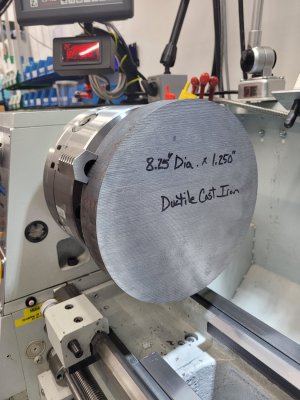
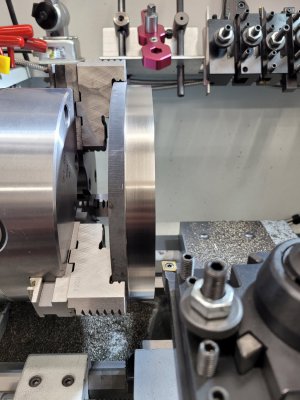
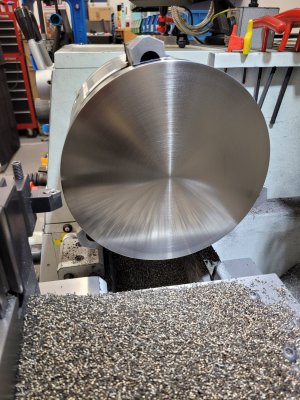
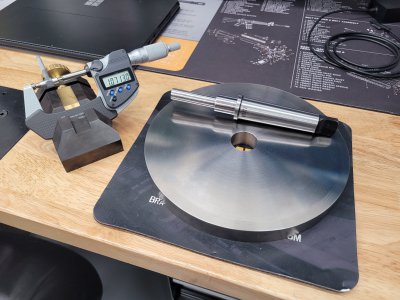
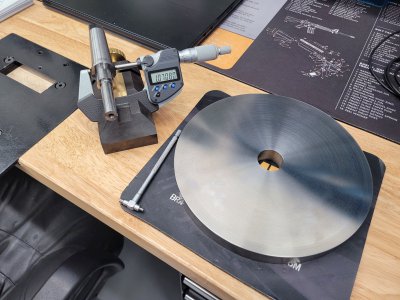
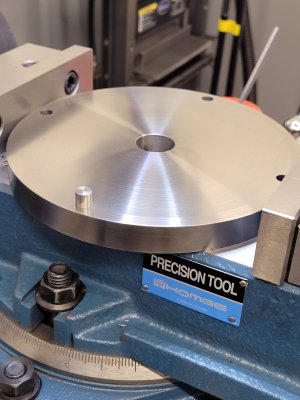
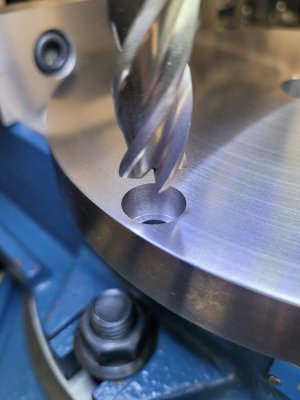
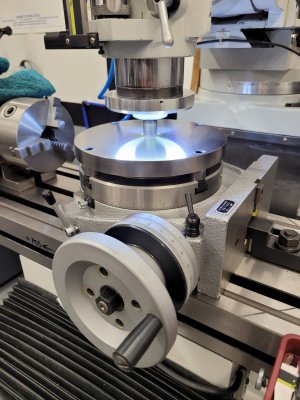
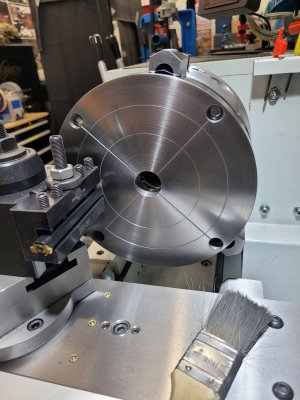
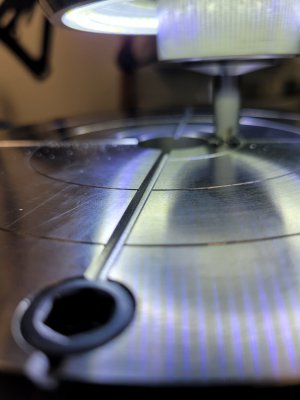
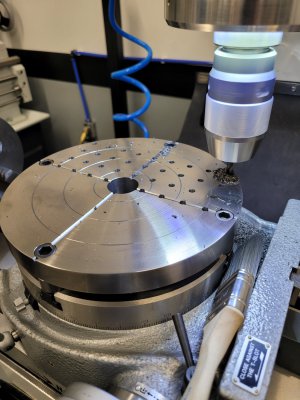
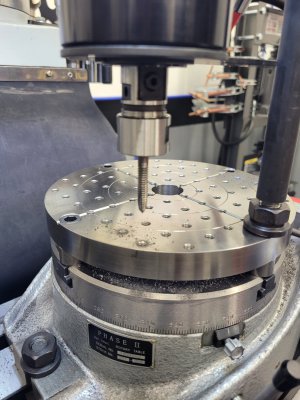
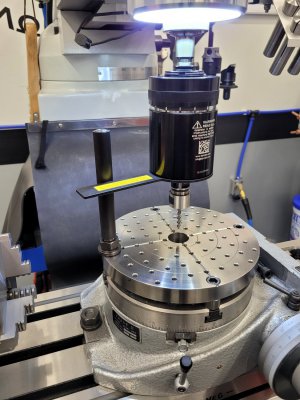
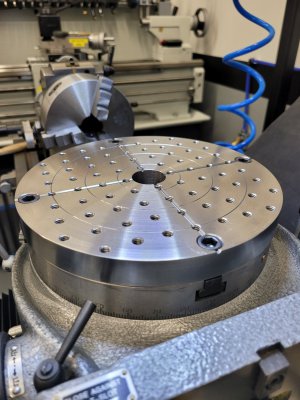
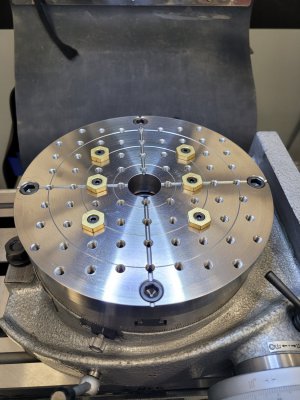
I started with a piece of 8.250" diameter x 1.250" ductile cast iron and chucked it up in my lathe.
I faced the first side and turned it to a diameter of 8" x .800" thick. Then I flipped it in the chuck jaws. This gave me a nice, square face to sit up against the jaws of the chuck to be able to machine the other side.
With the material now turned down to finished diameter and length, I bored a 1.0713" hole through the middle. This hole will mate up to the 1.0708" OD feature on a setup tool that I built to serve two purposes.....#1-to center my rotary table to the quill of my mill vía the MT3 taper, and #2-to center the fixture plate on the rotary table. I ended up with a bore .0005" over that of the setup tool.
I then set up the plate on the mill and indicated off of the bore to find center. With my X and Y axis zeroed, I drilled the mounting holes that would attach it to the rotary table. One of the feautures I wanted to have, was a relatively easy way to align the mounting bolts perfectly parallel and zero with the X axis at any given time. This would be especially useful, if (for whatever reason) I needed to remove the plate from the mill, unexpectedly, and then be able to set it up exactly where it was before. After a little brainstroming, I came up with an idea. The mounting holes would have a secondary purpose - a way to locate them using a precision pin. Step one was to drill undersized .367" holes that I then reamed to .375". These holes were drilled exactly 3.625" from center of the fixture plate at 0, 90, 180 and 270 degrees. Secondly, I parted off a 1" piece of .375" 01 tool steel in my lathe that would be used as the locating pin. Now if I ever wanted to align the fixture plate to the X or Y axis of my mill, I could center the rotary table, mount and center the fixture plate, zero the quill in both axis, adjust the quill to 3.625" from center and then (using the .375" locating pin in the quill) rotate my rotary table slightly until the pin just slipped into the mounting hole and then lock it all down.
With the precision holes drilled, I then used a 9/16" endmill to stepdrill the holes .375" deep. These would allow the mounting holes to sit just below flush of the fixture plate.
I initially engraved light grooves along the X and Y axis and was going to attempt to mill circular grooves at several different diameters, but this didn't work on the mill like I wanted. With the ability to remove and reinstall the plate on my mill to the same location (which now would pay off), I decided to put it back in my lathe and turn the circular grooves. I turned .015" deep grooves at 2", 4" and 6" diameter. Now back to the mill it went.
At this point I decided that the I wanted the previously engraved lines along the X and Y axis to serve a better purpose.....to center and hold round stock. So, using a 1/16" endmill, I milled .0625" deep grooves and then milled a nice 45 degree chamfer along the edges.
Next I drilled 76 holes using a #7 drill bit at .750" centers, added .030" chamfers and tapped them 1/4"-20.
***Note to self....never use a carbide tap to thread 76 holes in 3/4" cast iron, because when it snaps off inside the hole because you didn't adjust your new tapping head correctly, you will spend a good amount of time (if you're lucky enough to succussfully remove it) trying to chip it out piece by piece to save your project. Ask me how I know LOL!***
With all holes drilled and tapped, I then flipped the plate over, located the center and mounting holes, and then chamfered all holes.
After this project, I had to do a complete wipe- down of my lathe and mill to clean off all the graphite powder that had covered everything. It is terribly dirty material to machine.
Thanks for looking everybody, and Happy Machining!!!!
















